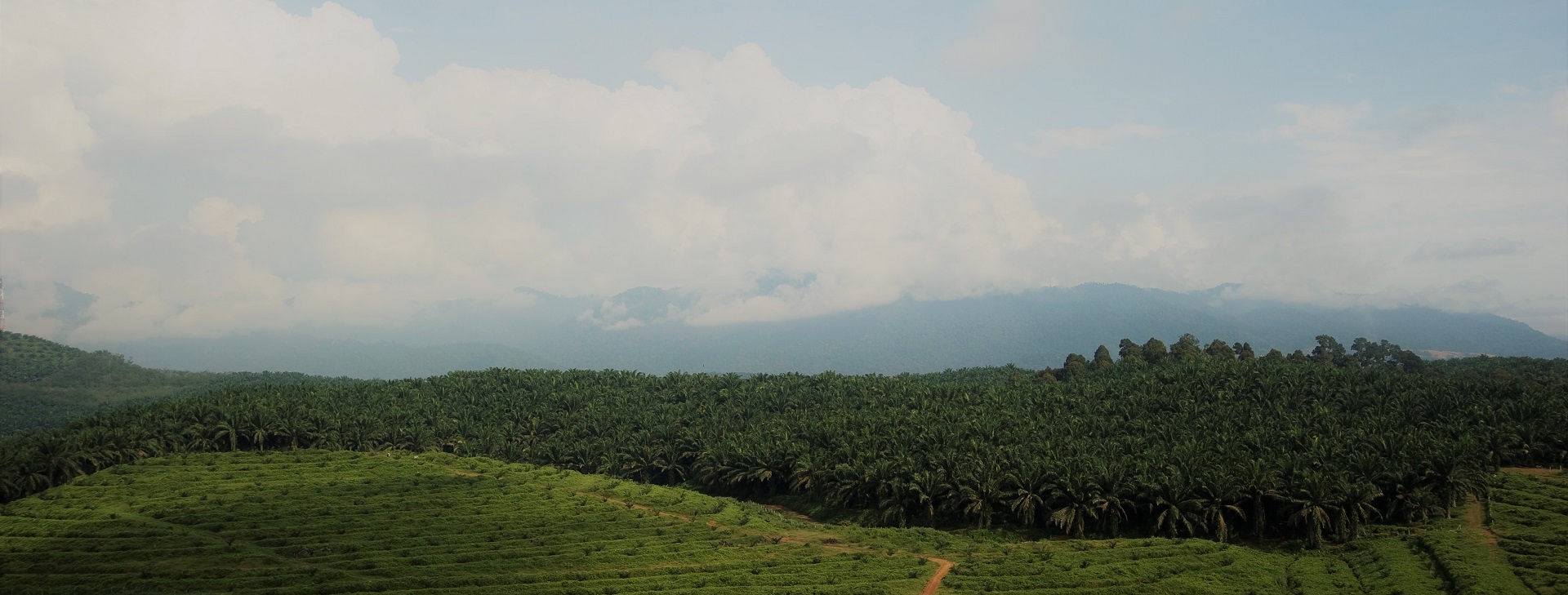Climate Action
Transitioning Towards Climate
Positive Business
Global temperatures are believed to increase by 1.5℃ before 2040. To keep the temperature fluctuation within 1.5℃, everyone needs to play a role to reduce their emission-posthaste.
We are no different, and our role in protecting and enhancing the environment guides our operations on the ground. Sime Darby Plantation (SDP) has a target; a 50% carbon intensity reduction by 2030, leading up to our Net Zero aspirations.
Our action plan is clearly mapped out. We are actively looking to restore degraded land, protect habitats, enhance responsible agricultural practices, and develop a circular economy through renewable energy. A major part of our focus is to drive deforestation out of our supply chain, a complex ecosystem.
While SDP has faced challenges in meeting our targets to climate-positive action, we have made significant investments to accelerate our ability to achieve our targets through infrastructure to support climate change adaptation and mitigation efforts.
Our Current Climate-Related Strategies
Investments to minimise upstream operational GHG Emissions
Biogas plants: Investing in biogas plants at mills to tackle SDP's largest emission source within our upstream operations. With these investments, we target to reduce emissions by 50% for upstream operations by 2030 against the 2009 baselines. Scope: Malaysia, Indonesia, PNG.
Solar energy: Implementing solar PV systems for SDP operations and supporting Malaysia's national schemes by leasing land for solar power generation systems.Scope: Malaysia
Operational efficiency: Continuously finding ways to improve operational efficiency with regards to energy, water, waste and chemical use.
Scope: SDP globally.
Implementing Nature-based Solutions
Conservation areas: Identifying and setting aside areas for conservation with plans to protect and restore these areas.
Tree planting intiatives: Conducting large-scale tree planting initiatives to boost sequestration and insetting / offsetting carbon footprint.
Scope: Malaysia, Indonesia, PNG, Solomon Islands.
Eliminating Deforestation from Our Supply Chain
Monitoring, engaging and supporting suppliers and smallholders to tackle deforestation in supply chains, in line with our Draw the Line Policy.
We target to ensure our supply chains are 100% deforestation-free by 2025.
Maintaining transparency of progress with supply chains through our traceability and Crosscheck platforms. We target to achieve 100% traceability by 2025.
Engaging in partnerships and multi-stakeholder initiatives on latest technologies and addressing challenges faced in supply chains.
Scope: Malaysia, Indonesia, PNG, Solomon Islands, Thailand.
Focus on Yield
Signficantly investing in R&D to boost yield and develop crop that is resilient to climate impacts.
Scope: Malaysia, Indonesia, PNG, Solomon Islands.
Protecting The
Environment
We are making efforts to minimise our environmental impact through carbon reduction and management of water, emissions, waste, and fire, as well as through our efforts to drive deforestation out of the supply chain. These measures are also integral contributors to the Sustainable Development Goals.
While Sime Darby Plantation has faced challenges in meeting our targets to reduce emissions, we have made significant investments to accelerate our ability to achieve our reduction targets through infrastructure to support climate change adaptation and mitigation efforts.
Climate Governance and Risk Assessment
Carbon Emissions Reduction
Renewable Energy
Air Emissions Management
Fire and Haze Management
Waste Management
Water Management
Enhancing The Environment
Sime Darby Plantation operates in some of the most biodiverse landscapes in the world, including Malaysia and Indonesia, both of which maintain a 50% forest cover. Understanding the need for and importance of conserving the natural expanse, we implement environmental management practices in our operations that are targeted at reducing biodiversity loss
Land Use Management
Peatland Conservation
Reforestation and Restoration
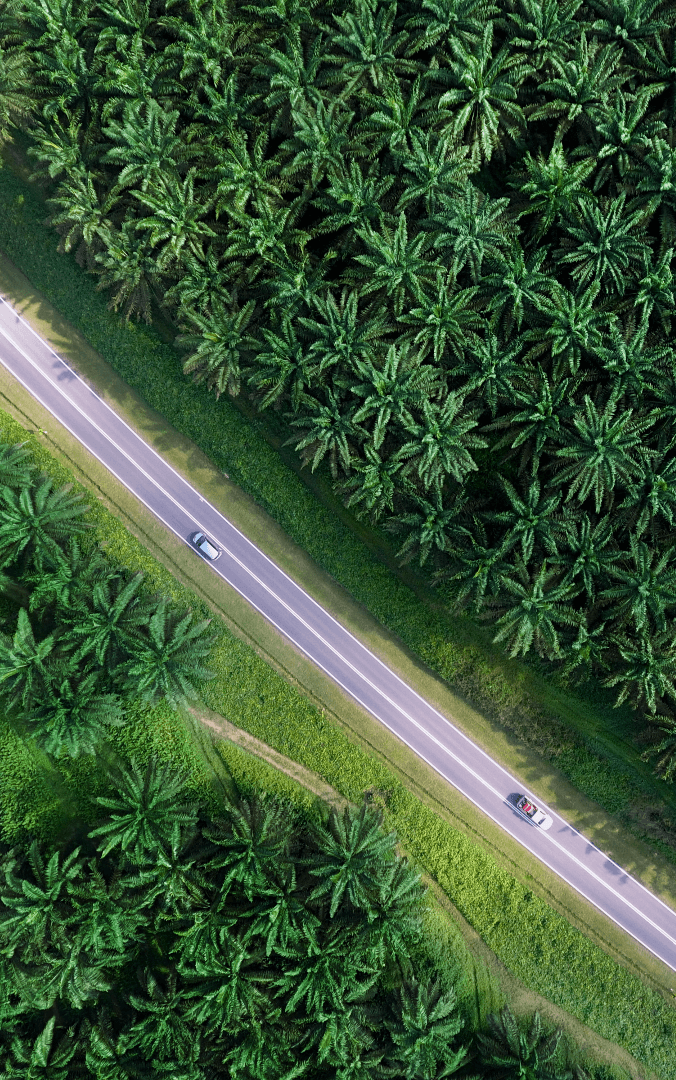
Carbon Emissions Reduction
Our Target: 50% reduction of carbon emissions by 2030
As the world's largest oil palm plantation company by planted area, we recognise the important role we play in managing carbon emissions and improving energy efficiency across our operations, to mitigate the adverse effects of climate change.
We have developed both near-term (2030) and net zero targets (2050), which have been submitted to the Science Based Targets initiative (SBTi) for validation.
SDP developed an ambitious roadmap to achieve net-zero emissions by 2050, focusing on 3 main areas:
- Acceleration of Renewables
- Land use Transformation
- Enhancing Supplier Engagement
For more information on our Net-Zero Roadmap, please visit https://simedarbyplantation.com/net-zero-emissions/
SDP uses the GHG Protocol Corporate Accounting and Reporting Standard and the Corporate Value Chain (Scope 3) Standard to calculate GHG emissions which comprise:
- Scope 1: Direct emissions from SDP’s owned and controlled sources
- Scope 2: Indirect emissions generated from purchased electricity and steam
- Scope 3: Indirect emissions that occur across SDP’s entire value chain.
The Group has enhanced the granularity of our GHG inventory by reporting our Scope 3 emissions this year.
SDP’s methodology primarily takes into account the following greenhouse gases: CO2, methane (CH4) and nitrous oxide (N2O). CH4 and N2O were converted into CO2 equivalents (CO2-e) based on their global warming potential from the IPCC Sixth Assessment Report. Some emission factors used (e.g. fuel emission factors as published by the UK Government GHG Conversion Factors for Company Reporting) were based on the IPCC Fourth Assessment Report (AR4) GWPs.
SDP’s Scope 1 and 2 consolidation and reporting on GHG emissions are based on the “control approach” i.e., the Group will account for 100% of emissions only from our upstream and downstream operations where it has direct operational control. Scope 2 emissions are calculated based on location-based method, which is the proxy for the market-based method.
Scope 3 emissions, namely Purchased Goods and Services, Capital Goods, Fuel and Energy related activities, were estimated using GHG Protocol’s Scope 3 Evaluator. Several Scope 3 categories are excluded as they are irrelevant to SDP’s operations – Upstream-leased assets, End-of-life treatment of sold products, Downstream-leased assets, Franchises, and Investments.
The Group is on a progressive journey to update and improve the accuracy of our reported emissions by reducing the level of estimation and by replacing the use of average data methodologies with more accurate data. These changes can affect both the emissions in a baseline year for SDP and the annual emissions it reports.
Understanding our emissions intensity at our downstream operations can be challenging due to the range of products and various processes at each operation.
In 2022, various energy saving projects were implemented across all the Group’s refineries. These include projects to improve condensate recovery, heat recovery and insulation, and replacing large motors with high efficiency motors. In addition, SDO also focused on increasing renewable energy consumption through the installation of solar panels on rooftops and the use of biogas. At our refinery in the Netherlands, a reverse osmosis plant was built; reducing the amount of water, energy and chemicals needed in the plant’s operations.
Resetting our Baseline Emissions
SDP’s carbon accounting has evolved in line with refinements of the methodology to measure emissions. To ensure completeness of our entire inventory, SDP undertook an exercise to re-establish our baseline emissions.
In 2020, we accounted 7,200,168 MT CO2e from our planting and replanting activities. Nonetheless, our operations also sequestered 6,071,361 MT CO2e from our conservation areas, standing oil palm and rubber trees, paulownia, buffer zones as well as mangrove in 2020. This number was validated by Eco-Ideal Consulting Sdn. Bhd.
Our 2022 GHG Emissions
In 2022, our Group operational GHG emissions amounted to 18,977,158 MT CO2e, covering our upstream and downstream business units:
- 10,375,646 MT CO2e for Scope 1
- 225,722 MT CO2e for Scope 2
- 8,375,789 MT CO2e for Scope 3
Our primary emission source derives from our Scope 1 land use change followed by purchased goods and services (Scope 3) and effluent treatment (Scope 1).
Chart under Our GHG Emissions
In 2022, the Group’s operations used 24,083,177 gigajoules (GJ) of energy. About 85% of the energy consumed was from renewable sources, namely biomass and biodiesel, contributed primarily by the Group’s renewable energy initiatives. The remaining 15% of the Group’s energy was derived from non-renewable sources such as fossil fuels. The Group’s use of renewable energy in 2022 has led to approximately 23 million tCO2e of emissions avoided in the year.
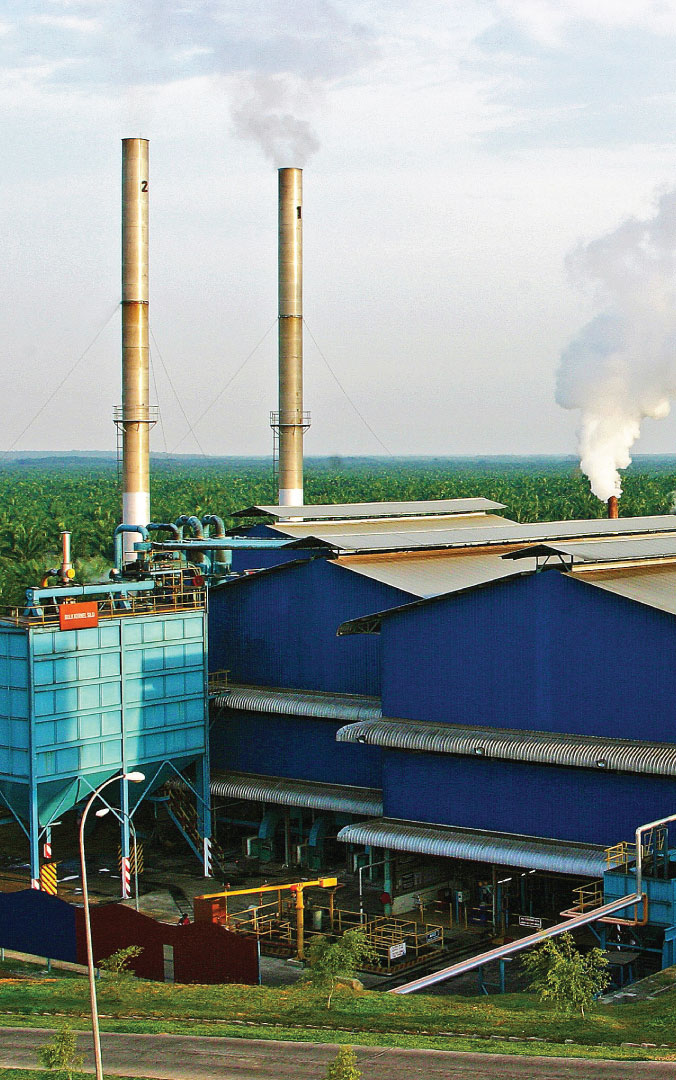
Air Emissions Management
We recognise that our mill operations are challenged with significant emissions such as dust and smoke from chimneys and particles from crushing plants, unlike our refineries that operate on natural gas.
In Malaysia alone, we have invested approximately RM70 Million to improve compliance with more stringent air emission standards by installing additional pollution control systems such as Electrostatic Precipitator and Vorcep at all our 33 mills. We have always complied with local environmental regulations. With the new limits required under the Clean Air Regulations 2014, we are upgrading our pollution control system to meet Total Particulate Matter (PM) of 150mg/m3 by December 2021 (from 400mg/m3 to limit value). Individual operating units report their air emission performance through our online Continuous Emission Monitoring System (CEMS).
Our new target is an ambitious 50% reduction in CO2e emissions by 2030 at our upstream operations.
GHG emission intensity at upstream operations reduced by 7.1% from 2019
Reduction of 1.8% in carbon emission intensity compared to 2009 baseline. We are ramping up our biogas initiatives to meet this target. Our 12 operational biogas plants contribute almost 500,000 MT CO2e emissions reduction.
Our renewable energy subsidiary, Sime Darby Plantation Renewable Energy Sdn Bhd (SDPRE), focuses on value-accretive activities in the renewable energy sector. We leverage the assets and by-products of SDP’s core business to strategically embark on solar, biogas, and biomass projects aligned with the Group’s sustainability goal of lowering carbon emissions. Since its inception, we have built and currently operate 12 biogas plants across Malaysia, Indonesia, and Papua New Guinea, and solar projects in Malaysia.
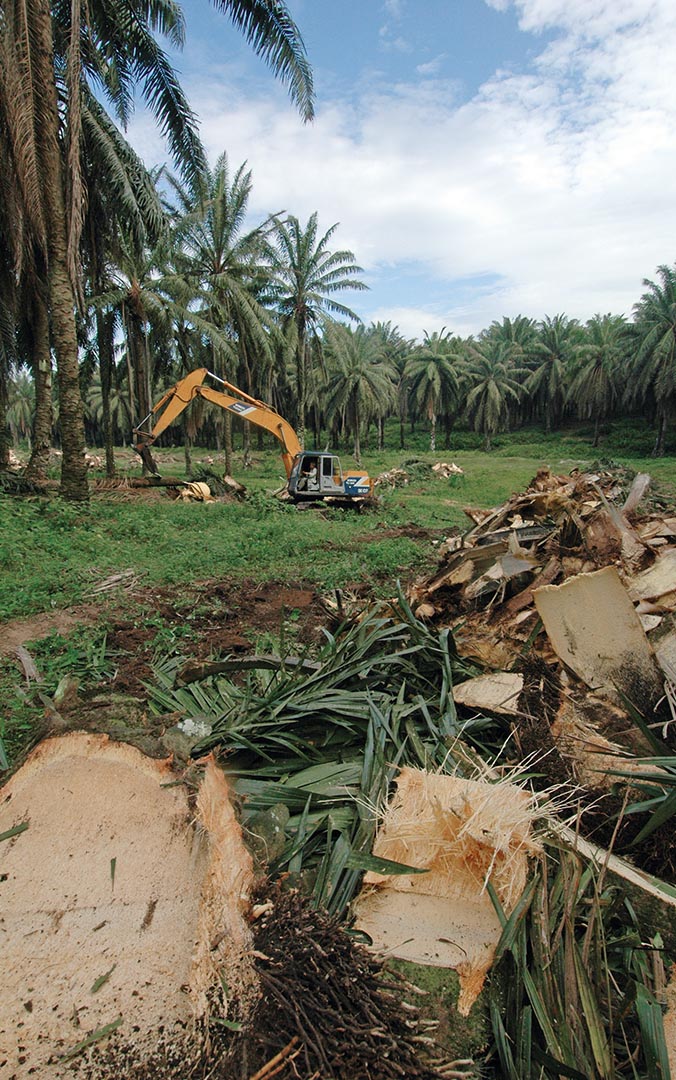
Fire and Haze Management
Sime Darby Plantation (SDP) pioneered and commercially introduced the 'Zero-Burning Replanting Technique' in 1985.
When clearing fields of old and unproductive palms, the trunks and fronds are cut and left on the fields to decompose as organic fertiliser. This environmentally friendly technique, improves soil quality, and has been adopted as the industry standard for oil palm replanting.
In 1992, SDP was admitted into the United Nations Environment Programme's (UNEP) Global 500 Roll of Honour for Environmental Achievement during the Rio Earth Summit for the development and commercialisation of this technique.
Fires can be caused by many factors and is most likely to occur during dry seasons. Our operations, as well as areas of our concessions occupied by local communities are susceptible to unpredictable fires.
We use satellite data to keep an eye out for fire occurrences in our estates as well as neighbouring areas. Once alerted, we immediately investigate and send our specially trained teams to put the fires out and prevent it from spreading and causing more damage.
Hotspot DashboardOur strict Zero Burning Policy extends within our own boundaries. However, because of our commitment to environmental stewardship, we have roped in our neighbours to commit to the same policy. This includes those within a 5km radius of our estate boundaries.
We not only assist our neighbours to monitor fire occurrences but also help to put out the fires as soon as we are alerted.
We have specially trained and fully equipped Fire Fighting Teams at our operations to help put out fires. They are the frontliners who safeguard our plantations and assist our neighbours as part of the 5km Zero-Burning commitment.
In Indonesia, a series of training programmes were conducted as follows:
Masyarakat Peduli Api (Local Communities Fire Awareness Movement)
Protecting the environment is a shared responsibility and who better to help us than the local communities who live and work with us.
Sime Darby Plantation has helped initiate 'Masyarakat Peduli Api' within neighbouring local communities in our Indonesian operations to increase their awareness and participation in fire prevention activities.
53 units of Menara Api are under construction and expected to be completed by end of 2021.
Since 2014, our subsidiary Minamas Plantation has partnered with seven universities across Indonesia to develop integrated community-based fire prevention programs (DMCA) involving all levels of stakeholders, to contribute in safeguarding the area from forest fires.
The programme aims to educate local communities in fire-prone villages around our operations about sustainable agricultural practices. We help them find sustainable and viable alternatives to generate income.
As of November 2021, the programme has covered 161,000 hectares and benefitted 67,000 people. Five new programmes have been initiated in West Kalimantan since 2020. Since its inception, a total of 34 villages have participated in the programme across Sumatera and Kalimantan in Indonesia.
The programme aims to educate local communities around our operations about sustainable agricultural practices. We help them find sustainable and viable alternatives to generate income.
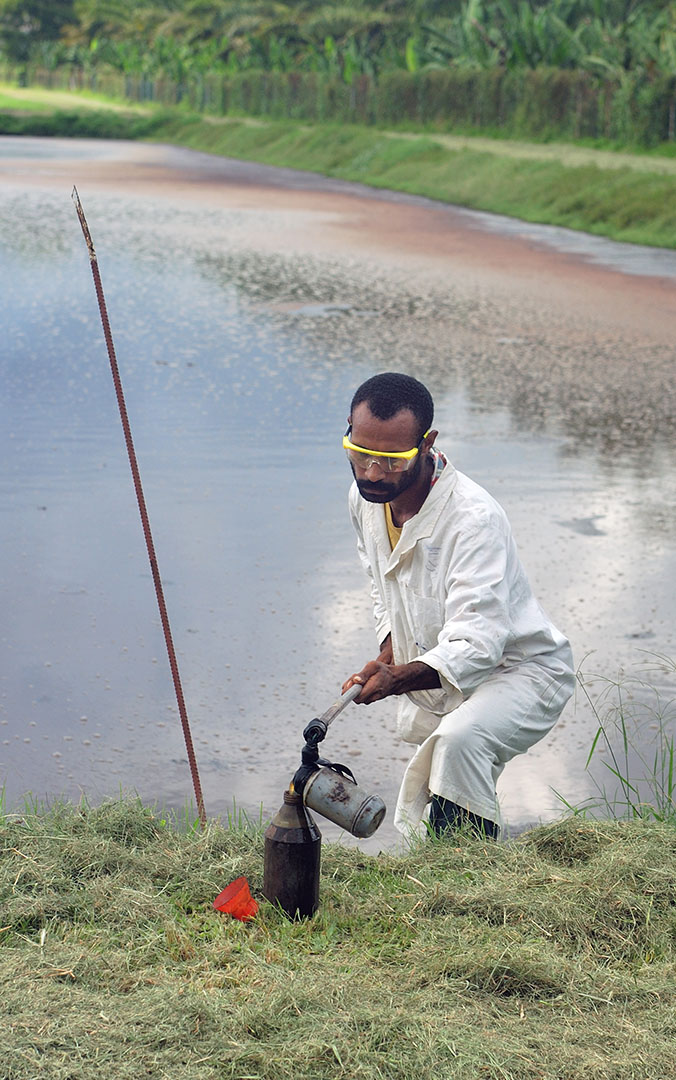
Waste Management
Palm oil Mill Effluent (POME) is the primary organic waste generated during the production of palm oil. Sime Darby Plantation does not discharge untreated effluent into water streams as it will cause considerable environmental harm.
Palm oil refinery effluent (PORE) is wastewater from the refining of crude palm oil (CPO). PORE treatment usually involves a chemical process to remove oil, grease and inorganic substances before further biological treatment prior to its discharge.
Our robust management systems ensure all our mills and refinery operations are fitted with Palm Oil Mill Effluent Treatment System (POMETS) and Industrial Effluent Treatment Systems (IETS) that support the management of waste and comply with national environmental standards.
We continuously monitor the quality of discharged wastewater and wastewater treatment performance at our upstream operations. We also ensure that biological oxygen demand (BOD) remains below regulatory thresholds in the regions where we operate - Malaysia, Indonesia, and Papua New Guinea (PNG) and the Solomon Islands (SI).
Composts can be produced through a combination of the two largest constituents of mill wastes, POME and Empty Fruit Bunches (EFB), as well as other by-products, including decanter cake and boiler ash. Composts are applied in estates as a soil conditioner to enrich the soil. Sime Darby Plantation began composting as part of its mill waste management in 2004.
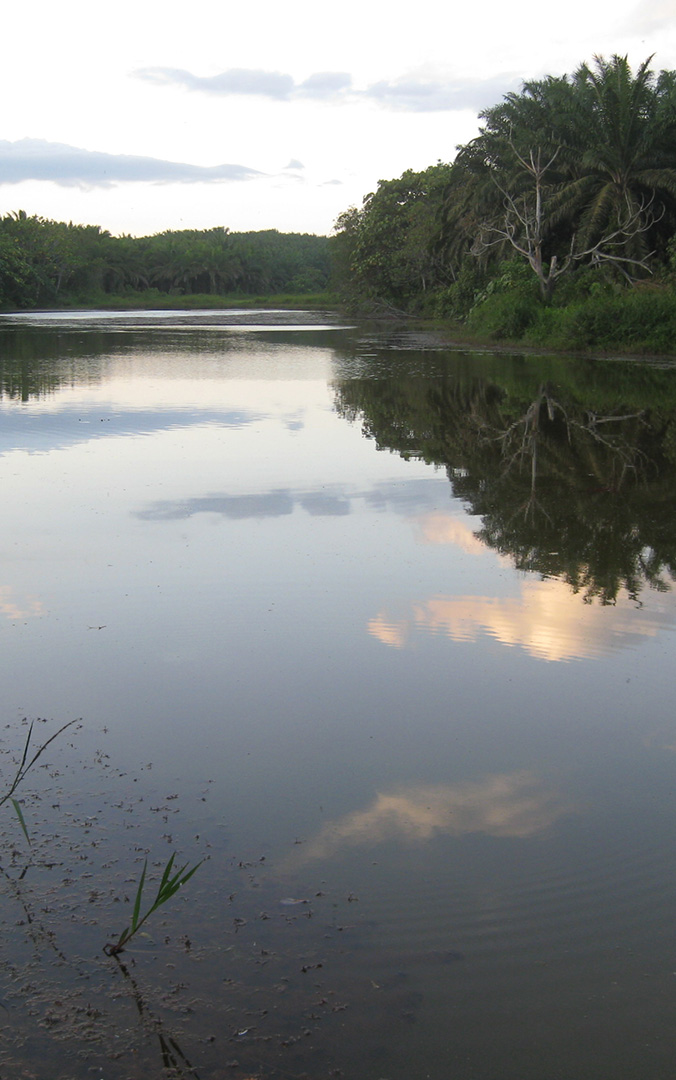
Water Management
The group monitors the amount of water used and usage intensity in all its upstream operations. In 2022, SDP consumed a total of 28,353,614 cubic metres (m3) of water across all upstream operations.
Each region primarily determines its water management and monitoring approaches according to regulatory requirements. Water data is collected at the site level and may vary from operation to operation. SDP is currently reviewing our internal processes to collect this data at the Group level, as doing so will ensure consistency and comparability. We have set a 5-year target of an annual water intensity reduction of 6% against baseline of 1.4m3 /tonne of FFB in 2019. We are currently streamlining our data collection approach and will refine our targets moving forward.
In 2022, the Group appointed external consultants to conduct a study on its water footprint and water business risks across its upstream and downstream operations. The study will be carried out in 2023 together with SDP’s R&D department. The study will be carried out with the Water Footprint Network methodology, and a life cycle assessment in line with the ISO 14046: 2014 Water Footprint standard.
Water Withdrawal (m3)
Average water usage per tonne of FFB processed (m3/MT FFB)
To further enhance our sustainability practices, we introduced new technologies to efficiently treat industrial wastewater in 2019 and 2020. Patent applications have been filed in Malaysia, Indonesia and Thailand on the process of treating palm oil mill effluent using electro-oxidation means and in Malaysia on the method for treating vegetable oil refinery effluent using electro-oxidation means. These efforts have made significant inroads into reducing our energy and water footprint.
Our top priority is to ensure our employees have access to safe drinking water and sanitation. We take periodic water samples from the river systems, and the results have shown no significant deterioration of water quality.
Our 2023 CDP Water Security responses can be accessed HERE.
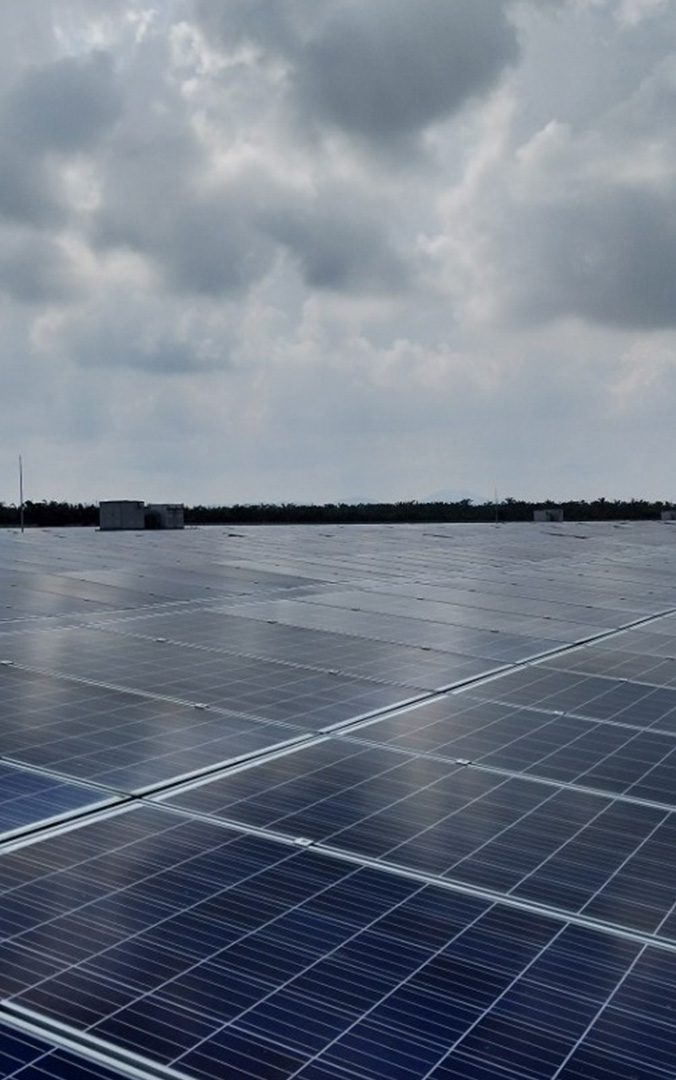
Renewable Energy
We aim to create a diverse portfolio of sustainable businesses while creating a circular economy for all the direct and in-direct stakeholders within our eco-system and beyond.
Globally, the conversations around climate change have taken centre stage with renewable energy at the forefront of solutions to reduce Greenhouse Gas (GHG) emissions. To help realise our carbon emission target, the Group set up Sime Darby Plantation (SDP) Renewable Energy Sdn Bhd in 2014 to establish ventures in co-developing our biogas plants, as well as other renewable energy initiatives such as solar and biomass.
Sime Darby Plantation Renewable Energy Sdn Bhd (SDPRE) is the subsidiary set up in 2020 to support the Group’s green initiatives. Its mandate includes establishing ventures to co-develop biogas plants as well as other renewable energy projects such as solar and biomass.
In addition to developing, executing and managing our own initiatives, SDPRE also works collaboratively with other parties on synergistic joint initiatives to explore other ways of deriving value from these by-products.
In 2022, we announced our commitment to achieving net-zero emissions by 2050. SDPRE plays a significant role in assisting the Group to achieve this target via technology-based initiatives. To demonstrate the seriousness of our commitment to reduce carbon emissions, more resources were allocated to SDPRE to expedite the implementation of renewable energy initiatives.
Renewable energy projects involving biogas, solar and algae have also been identified as business lines from FY2022 onwards. Hence, in addition to assisting in the achievement of our net-zero milestones and targets, SDPRE will also be expected to meet certain financial targets.
*For LSS1 and LSS4, as landowners we have leased parcels of our land to third parties who then build and operate the LSS plants. In this landowner/land tenancy model, we do not own the LSS plants. The development of LSS projects beyond those stated in the table above are currently dependent on a competitive bidding process to fulfil available Government quota for renewable energy as determined by the Energy Commission of Malaysia.
Highlights:
SDP Total Operational Emission by Source FY2021 (MT CO2e)
Methane emissions from treating effluent mainly from mill processes, is the single largest emission source of SDP’s operations.
SDP's biogas plants initiatives are not only vital in ensuring that we remain on track towards achieving our carbon reduction target.
Our biogas plants capture methane emitted from anaerobic wastewater treatment ponds that would otherwise be released into the atmosphere. Methane is a high-impact GHG and is created when Palm Oil Mill Effluent (POME) is stored in retention ponds. The captured biogas is then used to generate power that is either fed into the grid or powers our own operations, or flared, ensuring that methane is not released into the atmosphere.
Progress of our Biogas Plants initiative:
We aim to have a total of 49 biogas plants across our operations by 2030.
In FY2022, we commissioned two new biogas plants at Elphil and Kempas estates, bringing the total number of biogas plants in operation to 14 with a total capacity of 21.4 MW.
In the pipeline are 16 plants – three of which are currently under construction, five are at the pre-construction stage and the rest are still in development stages. Construction commencements are expected for two biogas plants in FY2023 – one in Sukamandang, Indonesia and the other in Sanggara, Papua New Guinea.
We are ramping up our capabilities to operationalise over 49 biogas plants by 2030 and 66 by 2050.
To support our carbon reduction plans, SDP Malaysia began installing photovoltaic (PV) systems in 2021. These are situated on the rooftops of our buildings and our land assets.
As of 2022, seven solar PV systems have been installed under the Net Energy Metering (NEM) and Self-Consumption (SELCO) schemes with a total capacity of 1,014 kWp. Moving forward, we are planning to install 81 solar rooftop systems across our assets, as an initiative to reduce our Scope 2 emissions and strengthen our approach towards the Group’s net-zero commitment.
We plan to install 81 PV systems across all our Malaysian operations by the end of 2025 (subject to site feasibility).
SDPRE has also started implementing battery energy storage and off-grid solar systems as part of its portfolio. The Group is currently developing two off-grid solar projects equipped with Battery Energy Storage Systems (BESS) at our assets, namely at our fertigation system in Sungai Buloh Estate which has a solar plant with a capacity of 25.92 kWp and 77 kWh BESS and at multiple areas in Jelata Bumi Estate with total of 859 kWp solar plants and 1,482 kWh BESS.
Supporting Malaysia’s carbon reduction plans.
SDP has also long supported Malaysia’s national carbon emissions reduction agenda, the Malaysia Renewable Energy Roadmap (MyRER). In support of Malaysia’s national agenda to reduce its carbon emissions, we leased our land to third parties to develop large scale solar plants under the Government’s large scale solar (LSS) scheme. The first LSS plant of 20 MW capacity was installed in Tali Ayer Estate in Penang and commenced operations in 2018. It has been generating stable income since 2019.
The development of 12 LSS4 projects with a total capacity of 336 MW is expected to be commissioned by the end of FY2023. Once all 12 LSS projects on our assets are commissioned, in total they will produce a projected total carbon emission reduction equivalent to planting 7,390,338 carbon capture trees as part of Malaysia’s carbon reduction targets.
We recycle the by-products of our upstream processes back into our operations as biomass. Our empty fruit bunches (EFB) are reused at our plantations as compost, POME is treated and used to irrigate fields, and palm kernel shells (PKS) are used as fuel for boilers at our mills. The team continues to explore the feasibility of valorising oil palm trunk, empty fruit bunch, palm kernel shell and biochar, by utilising them as fuel and other potential opportunities. This will significantly support our plans to reuse waste and offset emissions. The Group is actively seeking biomass business opportunities with international firms to offtake these by-products.
SDP is looking into capturing carbon from flue gas emitted by our operational boilers. To realise this, we are looking into carbon capture and sequestration using algae defensive technology to reduce our carbon footprint and promote the circular economy. We are planning to commence a trial phase in early 2023.
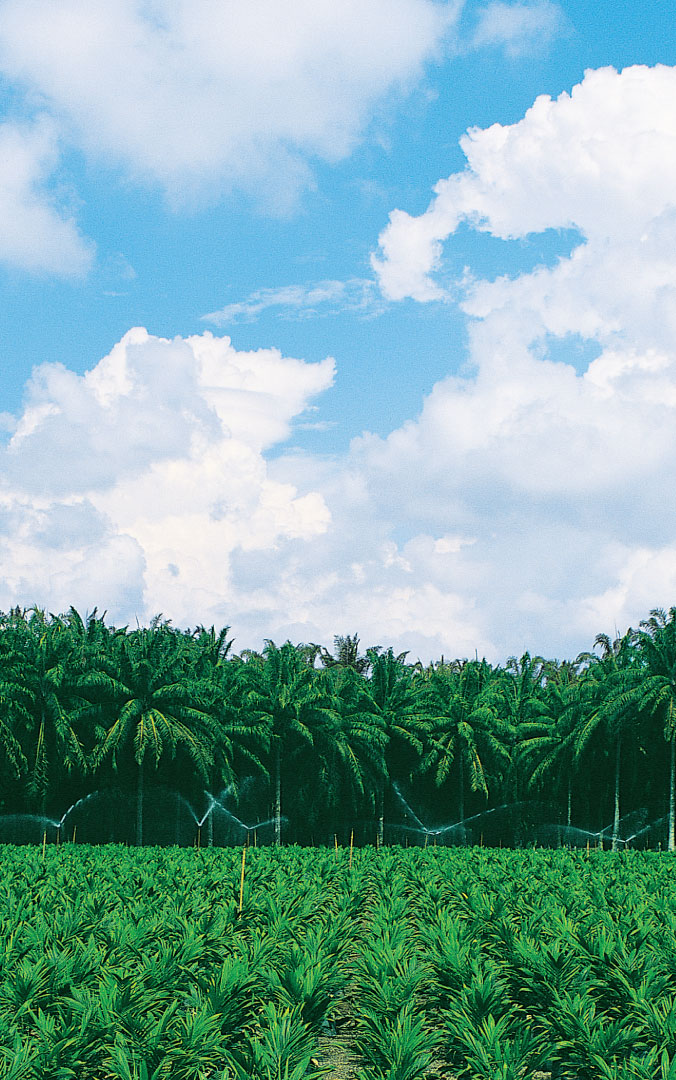
Climate Governance and Risk Assessment
We aim to provide greater transparency on our carbon footprint by monitoring and measuring our emissions to furnish accurate data on our performance.
We are continuously working towards improving the energy efficiency of our operations. We focus on emissions directly from SDP’s operations, including land clearing and preparation, planting, fertilising, harvesting, extraction and processing of raw materials. We currently do not manage emissions that are generated by third-parties who supply fresh fruit bunches.
In line with our intention to be part of global efforts to decarbonise the economy and mitigate the adverse effects of climate change, we set a target for reducing 50% of emission by 2030.
SDP’s climate governance covers the Board’s oversight of climate-related risks and opportunities, and the role of Management in assessing these risks and opportunities.
At the Board level, SDP’s climate governance is led by the Board Sustainability Committee (BSC). Key outcomes of the BSC meetings are escalated to the Board. In 2022, the BSC supported SDP’s Net-Zero Roadmap and targets, which were aligned with the Science-Based Target Initiative (SBTi).
Our 2023 CDP Climate Change responses can be accessed HERE
We have made strides in strengthening and enhancing the assessment of our resilience towards transition and physical risks to better understand the impacts of climate risks to the Group.
In 2022, we conducted a Climate Risk and Opportunities workshop that was represented by various business functions to identify and assess SDP’s most material transition risks in the short, medium and long-term horizons.
For physical climate risks, XDI carried out a physical risk assessment at West Estate and Mill, Carey Island, Malaysia and evaluated the long-term risk of hazards including coastal inundation, riverine flooding, extreme wind, soil movement, and others.
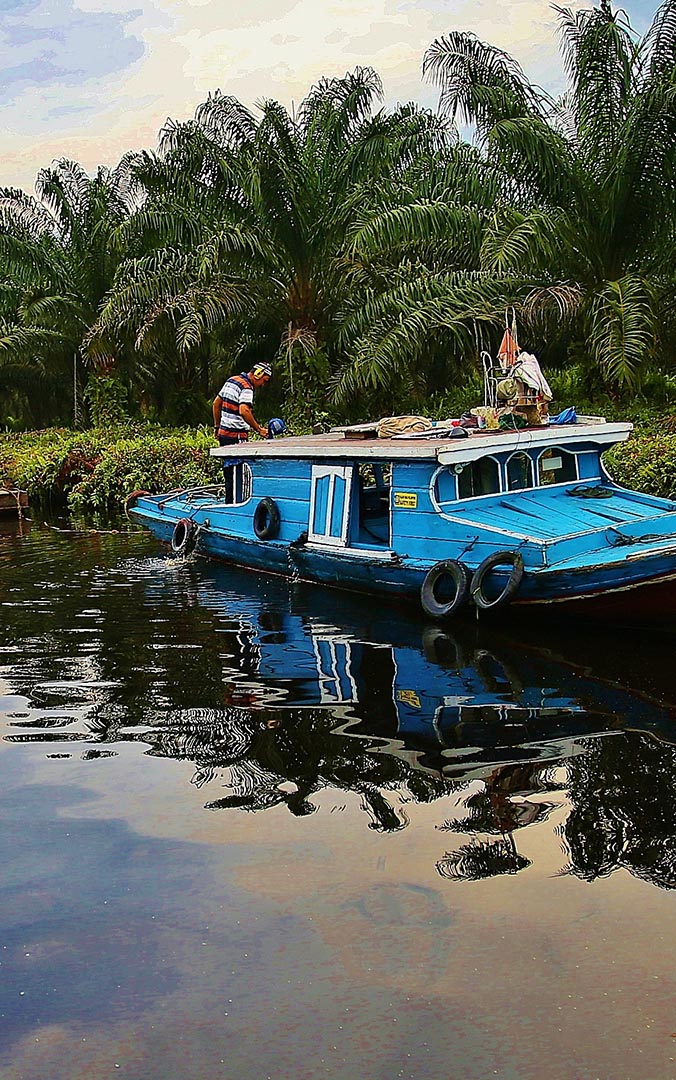
Peatland Conservation
SDP has implemented a strict policy of no new planting on peat since 2014. However, currently, 32,798 hectares of its plantations are located on peat across all operations.
Peatlands store twice as much carbon as the rest of the world’s forests and are more susceptible to fire. For this reason, the Group conducts drainability assessments at its existing operations on peat in accordance with RSPO requirements and uses the results to plan the phasing out of oil palm cultivation on these lands. Suitable crops will replace oil palms on these lands to generate a higher water table or rehabilitate natural vegetation. For peatland, it is crucial to maintain an optimal water level to maintain its vast stores of carbon, prevent peat fires and minimise peat subsidence.
In the interim, SDP’s operating units continuously implement best peat management practices in compliance with the RSPO principles and criteria and the Group’s internal agriculture reference manual. In addition, the Group maintains existing vegetation in and around its oil palm plantations and engages with surrounding local communities to educate their members on sustainable management of peat areas to prevent slash and burn activities.
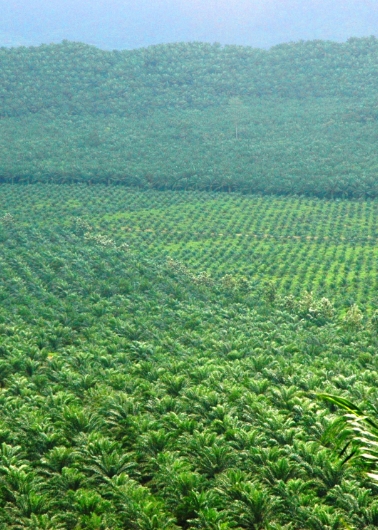
Land Use Management
Our large landbank enables us to meet the evolving human needs while continuing to advocate for the importance of conserving the ecological profile of our land.
We have a strict No-Deforestation policy that has been in place since July 2014. We use the High Carbon Stock Approach (HCSA) to estimate the amount of carbon and biodiversity stored in an area of land, to identify those that need to be preserved and protected.
The HCSA defines what constitutes forest landscapes in order to avoid deforestation. The methodology was developed by a broad group of companies and civil society organisations as a practical, transparent, robust, and scientifically credible approach that has become widely accepted, to implement commitments to protect forests in the tropics.
In addition to the HCSA method, we conduct independent High Conservation Value (HCV) assessments at our estates before new plantings or developments.
The assessments aim to identify HCV areas that may be negatively affected by our operations. The HCV assessments are conducted in conjunction with independent Social and Environmental Impact Assessments (SEIA) that are also carried out before new developments, including those by all of our suppliers. Where any loss of HCV biodiversity has been identified, we will develop Biodiversity Conservation Compensation Projects (BCCP) with Project-Affected Communities (PAC). Priority is given to in-situ remediation by planting Rare, Threatened and Endangered trees in conservation areas within Sime Darby Plantation's (SDP) operations.
We have a trained team that conducts HCV assessments in all our operating units to identify, categorise, protect and maintain high-risk zones. We also train our personnel on the ground on HCV management methods and the necessity to periodically monitor these areas to ensure the effectiveness of management activities.
SDP engages Assessor Licensing Scheme (ALS) Assessors for HCV Assessment or Integrated HCV – High Carbon Stock (HCS) Assessments for all new planting activities under the Roundtable on Sustainable Palm Oil's New Planting Procedure (NPP). This commitment is extended to all our suppliers. The reports can be accessed at High Conservation Resource Network.
New Britain Palm Oil (NBPOL) has become a member of global non-profit organisation The Forest Trust (TFT) with an initial focus on assessing and defining HCS forest areas in parallel with assessments of the needs of communities who live within our new concessions.
HCV surveillance is carried out using the annual two-fold approach, including the use of Satellite data, drones and ground truthing. All data is entered into GIS software (either SMART or QGIS) with a bi-annual remediation plan submitted where required and verified externally during annual audits by RSPO and Rainforest Alliance.
New Britain Palm Oil (NBPOL) has become a member of the global non-profit organisation The Forest Trust (TFT) with an initial focus on assessing and defining HCS forest areas in parallel with assessments of the needs of communities who live within our new concessions.
HCV surveillance is carried out using the annual two-fold approach, including the use of Satellite data, drones and ground truthing. All data is entered into GIS software (either SMART or QGIS) with a bi-annual remediation plan submitted where required and verified externally during annual audits by RSPO and Rainforest Alliance.
All HCV sites will have the SMART methodology run once a year and updated into the SMART reporting tool. To date five out of nine HCV sites implemented the methodology with the last four in progress. We are currently working on rolling out the methodology in Poliamba Ltd. and RAIL Ltd.
Spot Checks are carried out using Landsat and Sentinel imagery looking to identify any areas that are disturbed or have changes in land use within HCV areas. These areas are then ground-truthed to ensure necessary remediation plans can be put in place. To date five out of nine Spot Checks have been carried out.
Two additional NBPOL sites, RAIL Ltd and Poliamba Ltd. will start using the methodology developed by WNB Ltd. in 2019.
SDP’s conservation areas have remained largely unchanged over the years. As at end-2022, a total of 46,892 hectares – two thirds the size of Singapore – have been identified as HCV and conservation set-aside (CSA) areas with about 87% of the total conservation area located at SDP’s operations in Indonesia, and Papua New Guinea and Solomon Islands.
All HCV and CSA areas identified to date, have been set aside for conservation and are subject to dedicated management and monitoring plans. Measures include regular surveillance and patrolling for encroachment to prevent illegal development, poaching, and hunting. SDP also collaborates with the Forest Research Institute Malaysia to conduct biodiversity surveys to monitor wildlife within these areas, including endangered, rare and threatened species.
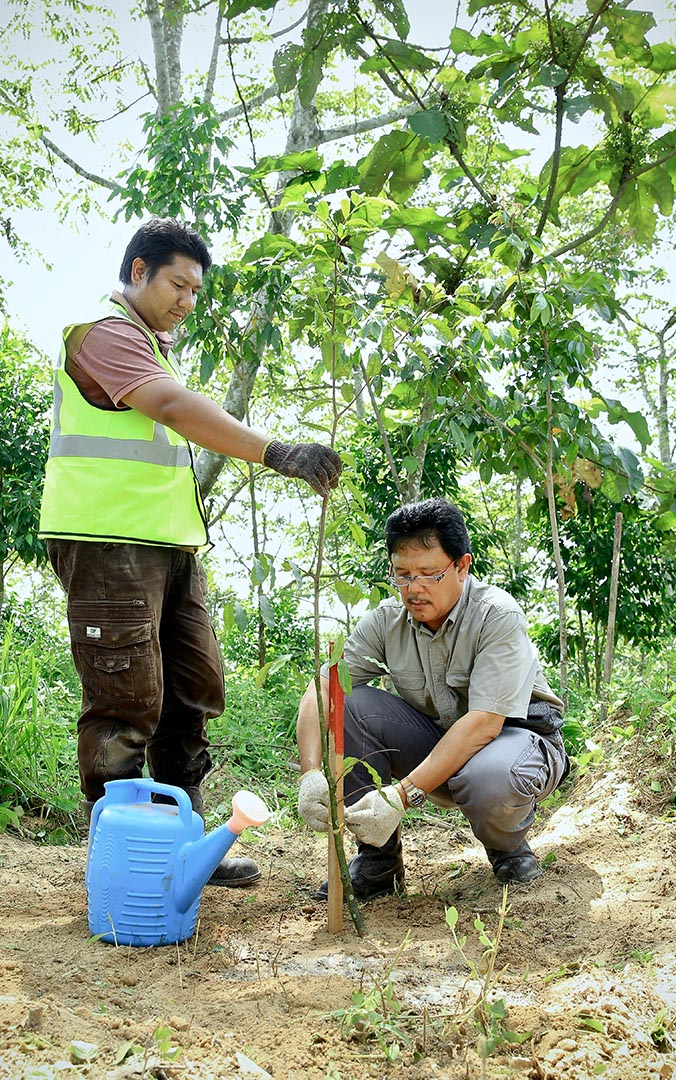
Reforestation and Restoration
Sime Darby Plantation is committed to ensuring the restoration of degraded forests and the reforestation of areas set aside for conservation in our concession areas. Where possible, we have planted Endangered, Rare and Threatened (ERT) trees to create wildlife corridors linking patches of degraded land.
Protect-Restore-Connect in a nutshell
Protect
Protect
Areas that are in good condition and have the potential for conservation. These could be areas that have been untouched and require less maintenance, depending on their present condition and quality.
Restore
Areas that are in good condition and have the potential for conservation. These could be areas that have been untouched and require less maintenance, depending on their present condition and quality.
Connect
Areas that have the potential to be connected with important habitats, landscapes and ecosystems. SDP’s focus in these areas will be on creating corridors, connectivity, steppingstones and extensions to such habitats and ecosystems.
We have 8,804.78 hectares of Conservation Side Aside areas throughout our concession areas, and have planted close to 1.9 million trees as of 31 December 2022. In 2022, a total of 997.36 hectares have been reforested within SDP’s concession areas.
Sime Darby Plantation pledged to assist the State Government of Sabah (represented by the Sabah Forestry Department) to conserve Orangutan habitats at the Bukit Piton Forest Reserve (previously known as Northern Ulu Segama). Bukit Piton is part of the Ulu Segama Malua Forest Reserve in the Heart of Borneo. The programme started in 2008 when an agreement was signed between the two parties to rehabilitate and restore the entire 5,400 ha of Bukit Piton Forest Reserve over a 10-year period, with a total commitment of RM25 million funded by Sime Darby Foundation.
About 300,000 trees from more than 95 species were planted in the area, also supporting the regrowth of natural vegetation. The trees and vegetation serves as food sources for Orangutans and other wildlife in the area. The project was successful, with multiple sightings of a large number of Orangutan nests in the rehabilitated areas. The success also included the reclassification from Class II Commercial Forests to Class I Protection Forests. It was renamed Bukit Piton Forest Reserve in March 2012 and had acquired the Totally Protected Area (TPA) status, which helped to improve the ecological functions of the forest.
The project was completed in 2018 and handed over to the Sabah Forestry Department during a closing ceremony held on 8 December 2018.
Sime Darby Plantation (SDP) collaborated with Sime Darby Foundation, the Management and Ecology of Malaysian Elephants (MEME) and the University of Nottingham Malaysia (UNM) to conduct research and obtain information on Human-Elephant Conflict (HEC) found in our Malaysian operations from 2011 to 2018.
This collaboration between the private sector, academia and the conservation world is a pioneering step for SDP to establish the science that can help manage HEC issues and protect wildlife while continuing to deliver value for the business. We have also established a standard operating procedure for human-wildlife conflict mitigation in the plantation.
Sime Darby Foundation has committed RM2.85 million to support MEME for the next three years (2020-2022) to develop conflict management approaches that cater to smallholders and other growers. This grant will assist in the development of a science-backed mechanisms to support the co-existence of human beings and endangered species.
This marks an overall contribution of RM8.11 million by the foundation since 2012, towards research and conservation management of wild Asian elephants.
Case Study SOP for Human-Wildlife Conflicts Mitigation in PlantationWe recognise that our plantations are habitats for diverse species that are endemic to the locations we operate in. Our plantations are also migratory corridors for wildlife that roam the forests. Thus, efforts are in place to connect some of these important wildlife corridors. For example, our operations in Papua New Guinea are home to the Queen Alexandra's Birdwing Butterfly (QABB) (Ornithoptera Alexandrae). The QABB is the world's largest butterfly, with wingspans of between 19cm and 30cm. It is endemic to northern Papua New Guinea, east of the Owen Stanley Mountains, and has an extremely small home range. The QABB is commonly found in Papua New Guinea's lowland rainforests, up to 900m above sea level. It mainly feeds on Aristolochia Dielsiana, a toxic pipevine species that plays a central role in its reproduction.
Through ongoing assessments, we have identified various species that are on International Union for Conservation of Nature (IUCN) red lists in our Papua New Guinea operations. We shall continue efforts to monitor and manage the species currently present in our plantations to ensure ecosystems continue to be protected.
With support from Sime Darby Foundation, a special lab has been constructed to facilitate the captive breeding of QABB. We aim to enhance the remaining population of this rare species by releasing adult bred specimens into areas of remaining forests where the pipevine plant is known to grow.
Tucked away in our Carey Island operations is Malaysia's first mangrove research centre that Sime Darby Plantation (SDP) established in 2019.
Located within the Company's West Estate, MRC is the research platform on the mangrove ecosystem and coastal zone management.
Among the objectives of the research centre are:
- To conduct phenology studies on mangroves seedlings available in and around Carey Island.
- To collect, establish, raise and manage mangroves nursery at Mangrove Research Centre, Carey Island.
- To plant, install and test the saplings using various methods at the eroded river buffer zone.
- To monitor and evaluate the survival and growth rates of the planted saplings.
- To expose and elevate the competency of internal researchers on mangrove science.
The latest project the centre is focusing on is the Carey Island River Rehabilitation Project. SDP's team has been planting Mangrove tree species to address major issues the island faces, including bunds breaking, riverbank erosion and mangrove degradation.
Planting Process
In 2022, SDP enhanced its Sime Darby Plant-A-Tree Programme. Going beyond planting trees, the Group launched the geotagging programme, an initiative to monitor the survival and mortality rate of the planted trees. To further increase awareness of the Group’s conservation efforts, SDP invited its employees to participate in the geotagging project as volunteers as part of the Group-wide “200 Years of Volunteerism” programme, which is aimed at giving back to the community in conjunction with SDP’s bicentennial.
Geotagging is the act of adding geographical identification data to photos, video, and other media recorded with smartphones or GPS-enabled electronic devices. The data consists of latitude and longitude coordinates and could also include timestamps or other contextual information. By geotagging a digital photo of a tree, we are also able to pinpoint the exact location of the geo-tagged tree and monitor it through satellites.
In 2022, the Group conducted five geotagging exercises across its estates which involved 323 volunteers from across the Group. A summary of the project by the end of 2022 is as follows:

